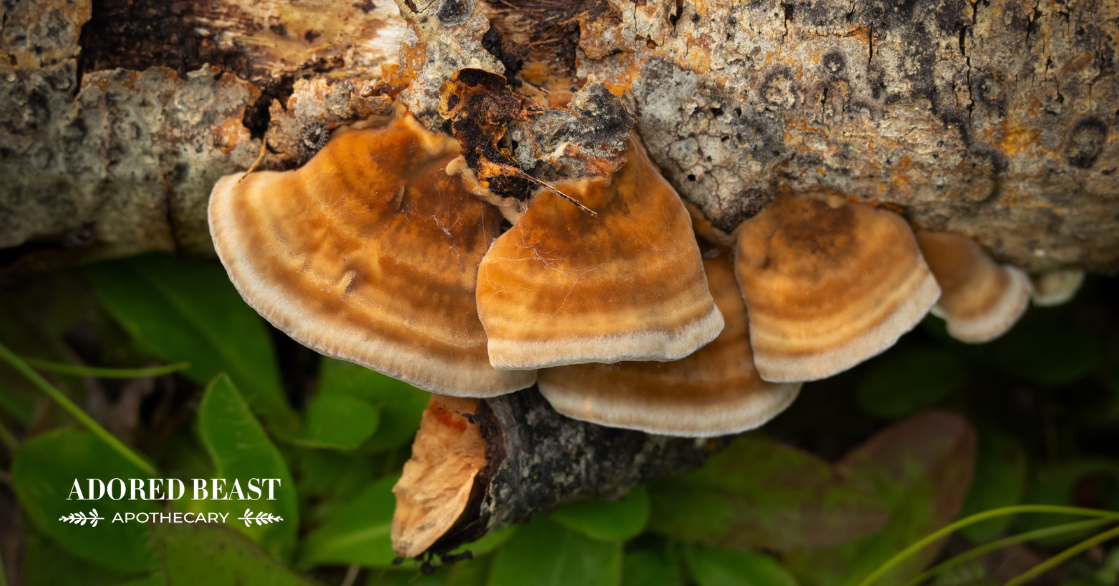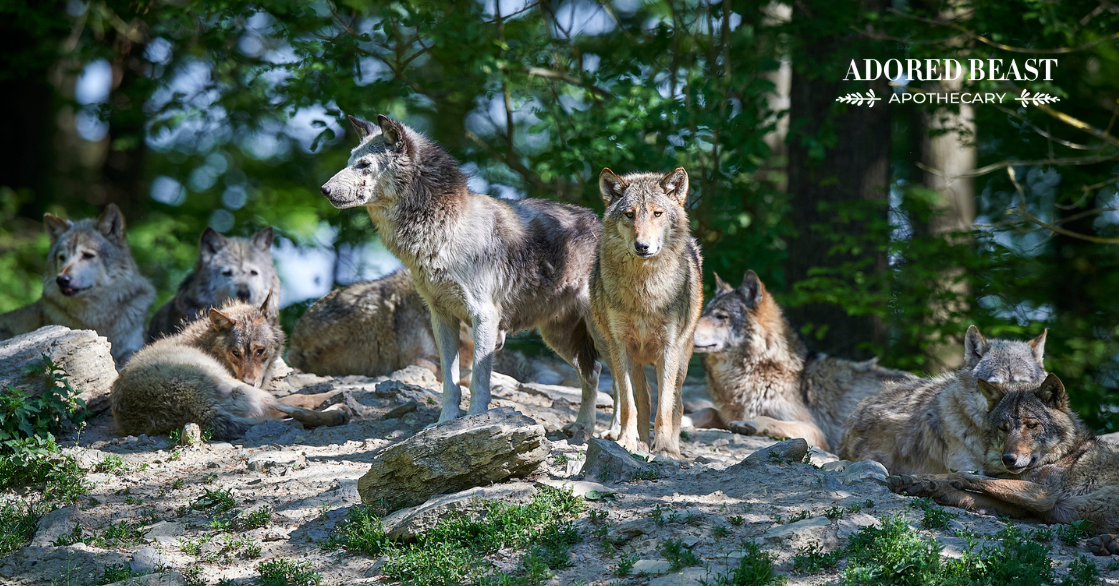We’ve all seen mushrooms growing out in the wild – whether in our backyards, in the park, or on the trail. We have several different kinds growing in yard right now.
When you do see them, do you ever wonder how the ones used in your animals’ supplements grow? Are supplement companies out there foraging for wild mushrooms? Sometimes, but not always. In fact, there are many different ways to grow a mushroom…
But does it really matter how mushrooms for pets are grown?
How are Mushrooms for Pets (& People) Grown?
While we often think of mushrooms and fungi as vegetables, they’re not. Unlike vegetables that come from seeds, mushrooms are fungi that start as spores
In the wild, in nature, mushrooms release their own spores which fall to the ground, are carried on the wind, or sometimes catch a ride on an animal’s fur. They can withstand harsh environmental conditions and remain dormant until they find a suitable substrate on which to develop into fungal mycelium (pretty brilliant). Then, once they’ve found a happy habitat, these spores grow on their own, on the first floor, in the soil, on dead logs, on tree trunks and more,
These spores germinate and grow mycelium beneath the surface, which bears a fruiting body. The mycelium provides the body of the mushroom with all the nutrients taken in from the growing medium. So, you could think about the mycelium as similar to the root and the fruiting body as similar to the fruit or vegetable that grows from the root. Just an FYI, many medicinal mushrooms do not have stems, including turkey tail and chaga!
FACT: Fruiting bodies and mycelium contain common and unique compounds that may benefit health – both are very valuable. Research shows that most mushrooms contain higher concentrations of bioactive compounds, such as beta-glucans and triterpenes, in the fruiting bodies as compared to mycelium. That said, there are compounds in the different mushroom varieties that are specific to the fruiting body or the mycelium! Mushrooms contain so many different compounds – including many that have yet to be isolated, let alone fully understood.
[RELATED] Medicinal Mushrooms for Dogs: The Power of Rotation
Mushrooms Grown Commercially
In commercial farming, spores are collected and mushrooms are grown in large, often sterile environments. Here, everything from temperature, to humidity, to lighting is controlled. And growers use several different materials to grow mushrooms on. Some common ones are:

- Rice
- Oats or other grains like sorghum
- Sawdust or wood chips
- Straw
- Manure
- Compost
- Logs
When it comes to producing mycelium, most companies grow it on cooked/sterilized rice, oats, sorghum, etc. Then, at harvesting or processing time, what actually happens is that the mycelium and the grain almost become one (mycelitated grain). It is extraordinarily difficult to separate the two. Therefore, more often than not, those materials are ground up and included in the extraction process with the end result being more starch than mushroom. It’s important to remember that mushrooms themselves do not contain starch.
In fact, according to research, mushrooms grown on grain can have as much as 30-60% starch! Can a mushroom product be a complete representation of these fungal organisms if it contains that much starch?
Mushrooms for Pets Grown in Nature
The way that we look at health at Adored Beast is to follow nature. We don’t want to try and put it in a box or force it to do what we think it should do. And that includes mushrooms for pets.
In fact, ABA founder Julie Anne Lee DCH feels that mushrooms grow the best with the most amount of medicinal value when they’re grown in their natural environment, when they’re given the chance to obtain all of that natural wisdom and nutrients from the environment. In fact, it’s what she is researching.
We know – and science is proving – that there are so many valuable bioactive compounds in dirt, in soil, in nature. We know that there is so much beneficial bacteria to be taken in during the growing process. It is our belief that mushrooms are no different and would get so much more from that healthy bacteria than, say, sterilized rice or any controlled growing method with grain (starch).
The mushrooms we use are grown in nature. Either in old growth forests, or clear-cut forests that have been lovingly rehabilitated. The forest bed upon which these mushrooms flourish and their natural water source is so full of diverse bacteria, and it’s this bacteria that our dogs’ ancestors would (and still do) have access to. Wolves, for example, can’t help but digest this beneficial bacteria – through their prey, licking their bodies, etc.
Of course, this makes it harder, more expensive, more unpredictable. Because we have very little control over the growing environment… But Julie believes it’s so important for us to consume things that have learned to be resilient to changes in the environment (ie. climate change). She believes that we have to learn how to adapt to what’s happening in our environment, just like things in nature do. Nature has a way, especially forests (and mushrooms), of adapting and becoming resilient when left to its natural abilities. When we ingest food that has not been tampered with, that has been grown in a natural setting, it already has that mechanism to survive.
Does it Matter?
Mushrooms are profoundly medicinal, and no matter how they’re grown, they’ll still be profoundly helpful. We are of the opinion, though, that there are certain benefits that can only come from mushrooms grown in their natural environment.
Mushrooms for pets (and people), whether from nature or grown commercially, are extremely powerful. They have the ability to flow through our animals’ bodies, providing value no matter how they’re grown. Whatever you’re comfortable with, that’s what you should be doing. That positive energy, and confidence knowing it will work, is crucial. And always remember, Nature wants us to heal… just something to keep in mind.












